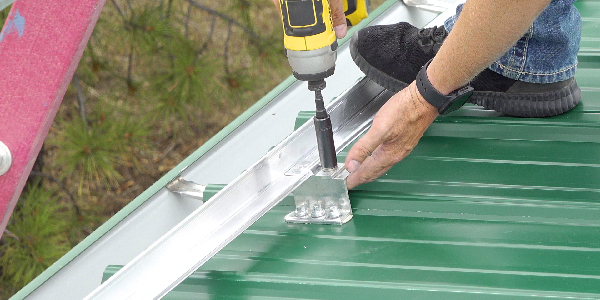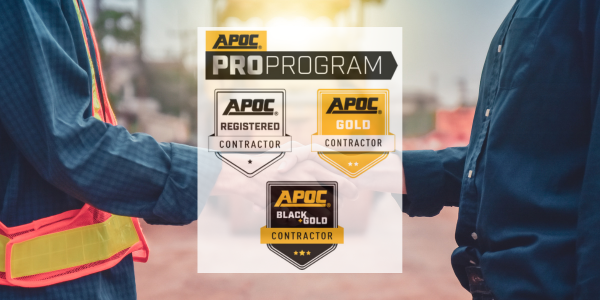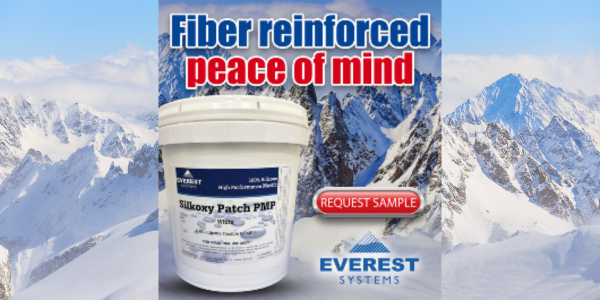The importance of using snow stops on EF roofs

By The Metal Roof Experts at S-5!
Installing snow stops on exposed-fastened metal roofs is crucial to keeping everyone and everything around a commercial building or home safe throughout the winter.
Editor’s note: Share this article with your customers who are considering installing a snow retention system on their roofs.
For those living in a snowy climate, it is imperative to have a snow retention system in place for the winter months. Whether it is a continuous snow fence or individual snow stops or snow guards that form a complete system, having these devices in place is key to safety. However, there are some considerations when it comes to deciding which of these systems is the best option for your roof.
Just before the winter months, S-5! received a question from a reader about exposed-fastened (EF) roofing. The question was “Why are snow stops considered the best option for EF roofs”. So, that’s what we aim to answer in the article below!
How do snow guards protect property and people?
The main reason to install snow stops or snow guards is to prevent snow from sliding off your roof, endangering people or property below. Many people mistakenly believe it’s a bad idea to retain snow on their roofs and want to let it slough off naturally. But this is a misperception. Avalanching snow from a rooftop poses safety concern and potential property damage. To reduce these risks, your rooftop snowpack needs to be properly restrained, using project specific data and proper design of an engineered snow retention system.

When snow accumulates on the roof, it can shed suddenly in a large, uncontrolled release. This “rooftop avalanche” may cause serious damage to the roof, gutters and anything on the ground below, such as landscaping, vehicular and other property-- and people – making it a life safety issue.
How do you engineer a reliable snow guard system?
There’s only one way to ensure rooftop snow doesn’t become a destructive avalanche. You need to engineer a snow retention system with the correct number, configuration and type of snow guards to withstand the specific forces acting on the sliding snowpack. Randomly adding snow stops to your EF roof is ignoring science and leaving things to chance or guesswork.
How do you become confident your system will adequately resist the forces? First, you need to know what those forces are. The forces of snow are measurable and must be calculated to design your snow guard system. You’ll need to work with a vendor who can calculate the forces for you or do it yourself. S-5! offers an online Snow Calculator to help you do this!
There are three parts to the design of a reliable snow stop or snow guard system:
-
The first task is to calculate the weight of the snow per square foot (using roof snow loads specific to your geographic location).
-
Once you have determined the weight in pounds per square foot (psf), the next step is to multiply that figure by your rafter length (eave to ridge) and then multiply that number by the sine of the roof angle. The result tells you what the force is for each linear foot of eave.
-
Next, you need to determine how the snow guard system will resist those forces without failing. The vendor should give you the tested “allowable” load of his attachments so that you can populate the attachments of the system appropriately.
Take note! If there are changes in any one of the variables (slope, roof length, etc.), the force will change as well. Learn how these forces are calculated in Metal Construction Association’s (MCA) White Paper, Metal Roof Design for Cold Climates.
Once you’ve identified the force per linear foot of eave, you can accurately engineer your system. Simply divide the force by the allowable holding strength of the snow stop to determine the number of attachments needed within a given area. (When the quotient is fractional, always round up.)
Here’s a quick example: if the math says the force is 500 pounds of force per linear foot and the attachment's allowable resistance is 1,000 pounds, you’ll need an attachment every two feet along the eave. With our Snow Guard Calculator, all the math is done for you. You just enter the roof slope, rafter length and snow load for your area.
Where do you attach the snow guards?
One of the most important things when attaching snow guards to an EF roof is to make sure your attachments extend through the roof into the substrate (or structure). Why? Because EF sheeting material alone isn’t strong enough to hold the attachment when the forces of snow bear down on it.
For example, five to six tons of snow can evacuate from the roof in a matter of seconds. Clearly, you need to rely on the strength of attachment to the structure or deck to resist such massive forces and not the roof sheet alone.
This makes project-specific testing critical because the substrate or structure of your roof varies from one project to another. Your deck might be wood oriented strand board (OSB) or 3/4-inch plywood, etc., – and purlin structure could be either wood or steel. Each of these has a different holding capacity. You need to know what that capacity is.
How do you choose the right snow guard system for your roof?
Now you know the forces your snow retention system needs to resist. You also learned the importance of substrate-specific testing. At this point, you’re ready to choose the best system for your project. Items to consider when selecting your system include:
- Your EF roof’s panel profile (corrugated, trapezoidal rib)
- The holding strength of the product/system selected in the substrate on your project
- Your aesthetic preference
- Cost
Installing snow guards or snow stops on your EF metal roof is critical in snow country to prevent rooftop avalanches. Forces resulting from the snow must be measured through scientific calculations using your geography’s roof design snow load information and your roof’s slope and rafter length. A change in any variable will alter the load, so be sure your calculations use job-specific information.
Always attach your system through the EF metal sheeting and into the deck or structure for reliable holding strength. Your roof profile, the system’s holding capacity, aesthetic preferences and cost will also factor into your choice of a snow guard system. Through proper engineering and best-practice design, you can be assured your snow retention system will restrain accumulating snow to prevent damage and potential injury for the life of the roof.
Original article source: S-5!
Learn more about S-5! in their Coffee Shop Directory or visit www.S-5.com.






















Comments
Leave a Reply
Have an account? Login to leave a comment!
Sign In